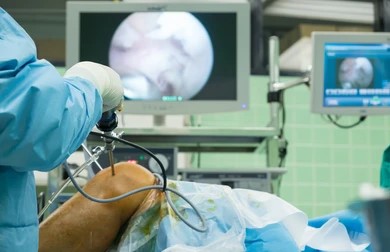Anterior Cruciate Ligament
The anterior cruciate ligament (ACL) is a vital stabilizing ligament in the knee joint that connects the femur (thigh bone) to the tibia (shin bone). Unfortunately, ACL injuries are common, particularly in sports and physical activities involving sudden stops, pivoting, or changes in direction. Such injuries can cause significant pain, instability, and functional limitations. Thankfully, advancements in medical technology, specifically arthroscopy, have revolutionized the treatment of ACL injuries.
ACL Tear
The ACL is responsible for providing stability to the knee joint, preventing excessive forward movement of the tibia and rotational instability. ACL injuries typically occur due to non-contact mechanisms, such as sudden deceleration, twisting, or landing awkwardly from a jump. These injuries are prevalent among athletes participating in sports like soccer, basketball, football, and skiing. The forceful stress placed on the ACL during these activities can result in sprains or complete tears of the ligament.

How does it impact?
An ACL injury can have a profound impact on an individual’s physical abilities, overall well-being, and quality of life. Common symptoms include severe pain, immediate swelling, limited range of motion, and a feeling of knee instability. Individuals with an ACL injury often struggle to perform routine activities, such as walking, running, and climbing stairs. Moreover, the psychological toll of losing the ability to participate in sports or physical activities can lead to frustration, depression, and decreased self-esteem
Arthroscopy as Treatment Option
Arthroscopy, a minimally invasive surgical procedure, has emerged as a highly effective treatment option for ACL injuries. It involves using a small camera, called an arthroscope, inserted through tiny incisions to visualize and repair the damaged structures inside the knee joint. Compared to traditional open surgery, arthroscopy offers several advantages, including reduced postoperative pain, faster recovery, and smaller scars

Arthroscopic ACL Reconstruction Process
Arthroscopic ACL reconstruction is a commonly performed procedure. It involves replacing the torn ACL with a graft, typically sourced from the patient's own patellar tendon, hamstring tendons, or a donor tendon. The surgeon creates tunnels in the femur and tibia to position the graft accurately. Using arthroscopic instruments, the graft is then secured in place using various fixation methods, allowing it to gradually integrate and provide stability to the knee joint. Throughout the procedure, the surgeon can visualize and manipulate the structures using the arthroscope, ensuring precise placement and minimizing damage to surrounding tissues
Advantages of Arthroscopic ACL Reconstruction
Arthroscopy offers several benefits when compared to traditional open surgery for ACL reconstruction. Firstly, the smaller incisions reduce the risk of infection and promote faster healing. Secondly, the procedure allows for more accurate visualization and evaluation of the joint, facilitating precise placement of the graft. Additionally, the use of arthroscopic instruments minimizes trauma to the surrounding tissues, resulting in less postoperative pain and faster rehabilitation. The ability to repair associated injuries, such as meniscal tears or articular cartilage damage, during the same procedure is another advantage of arthroscopic ACL reconstruction.
Postoperative Rehabilitation and Recovery
Following arthroscopic ACL reconstruction, a comprehensive rehabilitation program is crucial for a successful recovery. Physical therapy plays a significant role in restoring knee strength, range of motion, and stability. The rehabilitation process typically involves a progressive series of exercises, aimed at improving muscle strength, joint mobility, and proprioception. The duration of the recovery period can vary depending on the individual, but most patients can expect to return to their pre-injury activities within six to twelve months.
